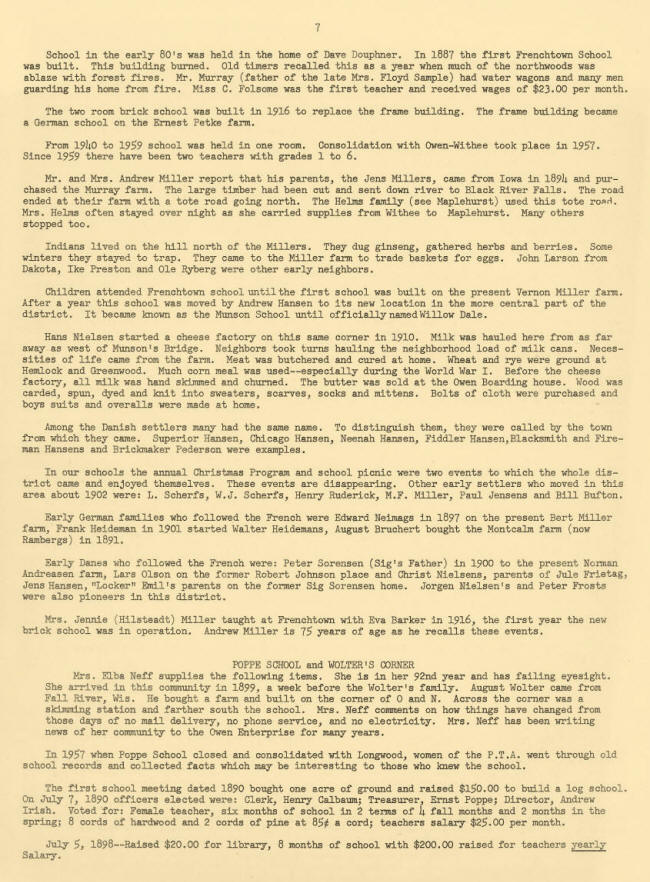|
[Memory
Trails Index]
Transcription
Janet Schwarze
School in the early 80’s
was held in the home of Dave Douphner. In 1887 the first Frenchtown School was
built. This building burned. Old timers recalled this as a year when much of the
north woods was ablaze with forest fires. Mr. Murray (father of the late Mrs.
Floyd Sample) had water wagons and many- men guarding his home from fire. Miss
C. Folsome was the first teacher and received wages of $23.00 per month.
The two room brick school was built in 1916 to replace the frame building. The
frame building became a German school on the Ernest Petke farm.
From l910 to 1959 school was held in one room. Consolidation with Owen-Withee
took place in 1957. Since 1959 there have been two teachers with grades 1 to 6.
Mr. and Mrs. Andrew Miller report that his parents, the Jens Millers, came from
Iowa in l89I and pin’- chased the Murray farm. The large timber had been cut and
sent down river to Black River Falls. The road ended at their farm with a tote
road going north. The Helms family (see Maplehurst) used this tote road.
Mrs. Helms often stayed over night as she carried supplies from Withee to
Maplehurst. Many others stopped too.
Indians lived on the hill north of the Millers. They dug ginseng, gathered herbs
and berries. Some winters they stayed to trap. They came to the Miller farm to
trade baskets for eggs. John Larson from Dakota, Ike Preston and Ole Ryberg were
other early neighbors.
Children attended Frenchtown school until the first school was built on the
present Vernon Miller farm. After a year this school was moved by Andrew Hansen
to its new location in the more central part of the district. It became known as
the Munson School until officiallynainedWillow Dale.
Hans Nielsen started a cheese factory- on this same corner in 1910. Milk was
hauled here from as far away as west of Munson’s Bridge. Neighbors took turns
hauling the neighborhood load of milk cans. Necessities of life came from the
farm. Meat was butchered and cured at home. Wheat and rye were ground at Hemlock
and Greenwood. Much corn meal was used--especially during the World War I.
Before the cheese factory, all milk was hand skimmed and churned. The butter was
sold at the Owen Boarding house. Wood was carded, spun, dyed and knit into
sweaters, scarves, socks and mittens. Bolts of cloth were purchased and boys
suits and overalls were made at home.
Among the Danish settlers may had the same name. To distinguish them, they were
called by the town from which they came. Superior Hansen, Chicago Hansen, Neenah
Hansen, Fiddler Hansen, Blacksmith and Fireman Hansens and Brick maker Pederson
were examples.
In our schools the annual Christmas Program and school picnic were two events to
which the whole district came and enjoyed themselves. These events are
disappearing. Other early settlers who moved in this area about 1902 were: L.
Scherfs, W. J. Scherfs, Henry Ruderick, M. F. Miller, Paul Jensens and Bill
Bufton.
Early German families who followed the French were Edward Neimags in 1897 on the
present Bert Miller farm, Frank Heideinan in 1901 started Walter Heidemans,
August Bruchert bought the Montcalm farm (now Rambergs) in 1891.
Early Danes who followed the French were: Peter Sorensen (Sig’s Father) in 1900
to the present Norman Andreasen farm, Lars Olson on the former Robert Johnson
place and Christ Nielsens, parents of Jule Frietag, Jens Hansen, “Locker” Emil’s
parents on the former Big Sorensen home. Jorgen Nielsen’s and Peter Frosts were
also pioneers in this district.
Mrs. Jenxiie (Hilsteadt) Miller taught at Frenchtown with Eva Barker in 1916,
the first year the new brick school was in operation. Andrew Miller is 75 years
of age as he recalls these events.
POPPE SCHOOL and WOLTER‘S CORNER
Mrs. Elba Neff supplies the following items. She is in her 92nd year and has
failing eyesight. She arrived in this community in 1899, a week before the
Wolter’s family. August Welter came from Fall River, Wis. He bought a farm and
built on the corner of O and N. Across the corner was a skimming station arid
farther south the school. Mrs. Neff comments on how things have changed from
those days of no mail delivery, no phone service, and no electricity. Mrs. Neff
has been writing news of her community to the Owen Enterprise for many years.
In 1957 when Poppe School closed and consolidated with Longwood, women of the
P.T.A. went through old school records and collected facts which may be
interesting to those who knew the school.
The first school meeting dated 1890 bought one acre of ground and raised $150.00
to build a log school. On July 7, 1890 officers elected were: Clerk, Henry
Calbaum; Treasurer, Ernst Poppe; Director, Andrew Irish. Voted for: Female
teacher, six months of school in 2 terms of ii. fall months and 2 months in the
spring; 8 cords of hardwood and 2 cords of pine at 85 a cord; teachers salary
$25.00 per month.
July 5, 1898--Raised $20.00 for library, 8 months of school with $200.00 raised
for teachers yearly Salary.
[Next]
[Memory
Trails Index]
|
